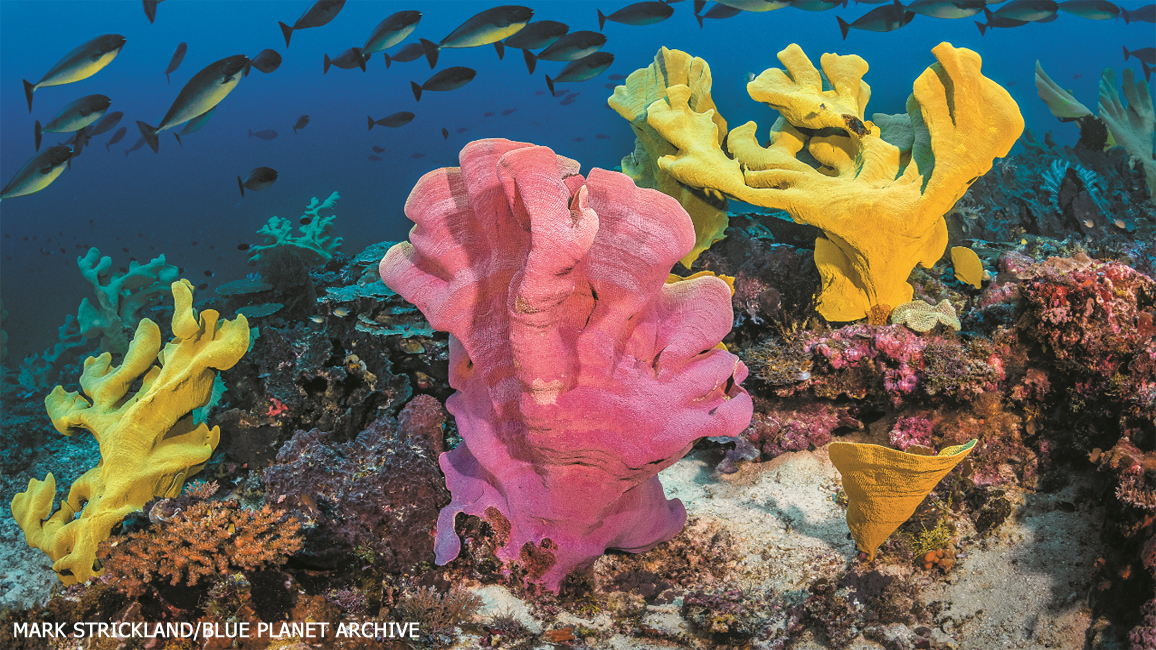
Meet the Sponges
By Soggy Sponge, as told to Kathy Kranking; art by Jack Desrocher
Hi! I’m Soggy Sponge. And I’m here to help you soak up some facts about my sponge-tacular family. It’s hard for me to believe, but some people actually think sponges are boring! Long ago, scientists even thought sponges were plants. It’s true that, unlike most other animals, my relatives and I don’t have hearts, lungs, or even brains. But sponges get along fine without all those—and also without eyes, mouths, or noses. As I always say, you don’t need a face to be fascinating!
Sponges can do things a person could never do. For instance, we breathe and eat through tiny holes, called pores, all over our bodies. Sponges are all about pores! We pump water in through them, taking food bits and oxygen from the water. Then we pump the water, and any wastes, back out. In just one day, a sponge the size of a gallon milk jug can pump enough water to fill a backyard swimming pool! Nothing boring about that, huh?
Sponges are amazing in other ways, too. We can be as beautiful as a sculpture, as colorful as a rainbow, as tiny as a pinhead, or bigger than a person! Swim over to the next page to find out more.

To “sponge” sometimes means to take something from someone for nothing. Many creatures like to sponge off of us sponges in different ways, but we don’t mind. A sponge can be like a neighborhood for fish, crabs, shrimp, and other animals. These creatures crawl inside the sponge’s openings to hang out, take a rest, or hide from enemies.
Other spongers hide out in the open—by being sponge copycats. Frogfish, for example, have spongy-looking skin and knobby shapes growing from their bodies. They sit on or next to a sponge, blending in as if they were part of it. That can fool hungry enemies. Or it can fake out prey animals that don’t notice the frogfish—until it’s too late.
And then there are the sponge crabs. They use us to make disguises to hide from enemies. With their claws, they snip off pieces of sponge. Then they “wear” them over their shells. Instant sponge costumes!
So whether it’s being used for hanging out, hiding out, or even faking out, a sponge usually has lots of company!

Don’t be fooled by our soft, spongy looks. We’re a lot tougher than you might think! OK, so sponges don’t have claws, teeth, or hard shells like some other animals. But we can still take care of ourselves.
Most sponges have a secret weapon: chemicals that are bad-tasting, bad-smelling, or even poisonous. The chemicals can discourage predators from eating us. They can also keep plants or corals from growing too close to us—we don’t like to be crowded! The chemicals can even keep bacteria and tiny plants from settling on us and blocking our pores.
Scientists are studying the chemicals that we sponges make. They think these may be used to make medicines to fight deadly human diseases. Who knows? Someday a sponge may save your life!
Though chemicals keep us sponges pretty safe, there are still animals that eat us, including some sea turtles, sea slugs, sea stars, and fish. But here’s the good news: Sponges have yet another secret weapon. We have the power to grow back lost or damaged parts. How cool is that?
Of course, there’s another thing we sponges can do to survive: make more sponges! Different sponges do this in different ways. One way is by releasing eggs into the water. Tiny larvae (LAR-vee) hatch from the eggs and spend some time swimming around. That’s the only opportunity we sponges get to swim! After a while, the larvae find rocks, coral, or other places where they can settle down. Then they grow into adult sponges like me.

My family is huge! There are more than 5,000 species of sponges. A few live in fresh water, but most live in oceans worldwide. Since each sponge is stuck in one place, we can’t get together for family reunions. So I keep a photo album of my favorite relatives. Have a look!
Well, I think I’ve squeezed out everything I know about sponges. Now that you’ve sopped it all up, you know what I’ve known all along: There’s nothing as spectacular as a sponge.
















